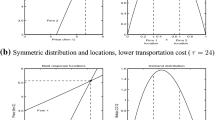Abstract
This paper examines the commodity price equilibrium problem in a spatially extended market. The earlier continuous equilibrium modeling approach is extended by explicitly taking into account congestion effects. An optimization model with a flow-dependent transportation cost function is proposed and its dual formulation in terms of a potential function is derived. The complementarity conditions between the primal and dual problems are shown to be equivalent to the spatial price equilibrium conditions with congestion effects.
Similar content being viewed by others
References
Beckmann, MJ, Puu, T (1985) Spatial economics: density, potential and flow. Studies in regional science and urban economics. Elsevier, New York
Tobler, WR (1985) Derivation of a spatially continuous transportation model. Transp. Res.19A: 169–172
Yang, H, Yagar, S, Iida, Y (1994) Traffic assignment in a congested discrete/continuous transportation system. Transp. Res.28B, 161–174
Zhang, Wei-Bin (1991) Synergetic economics: Time and change in nonlinear economics. Springer, Berlin Heidelberg
Author information
Authors and Affiliations
Rights and permissions
About this article
Cite this article
Yang, H. A spatial price equilibrium model with congestion effects. Ann Reg Sci 30, 359–371 (1996). https://doi.org/10.1007/BF01581949
Received:
Accepted:
Issue Date:
DOI: https://doi.org/10.1007/BF01581949




